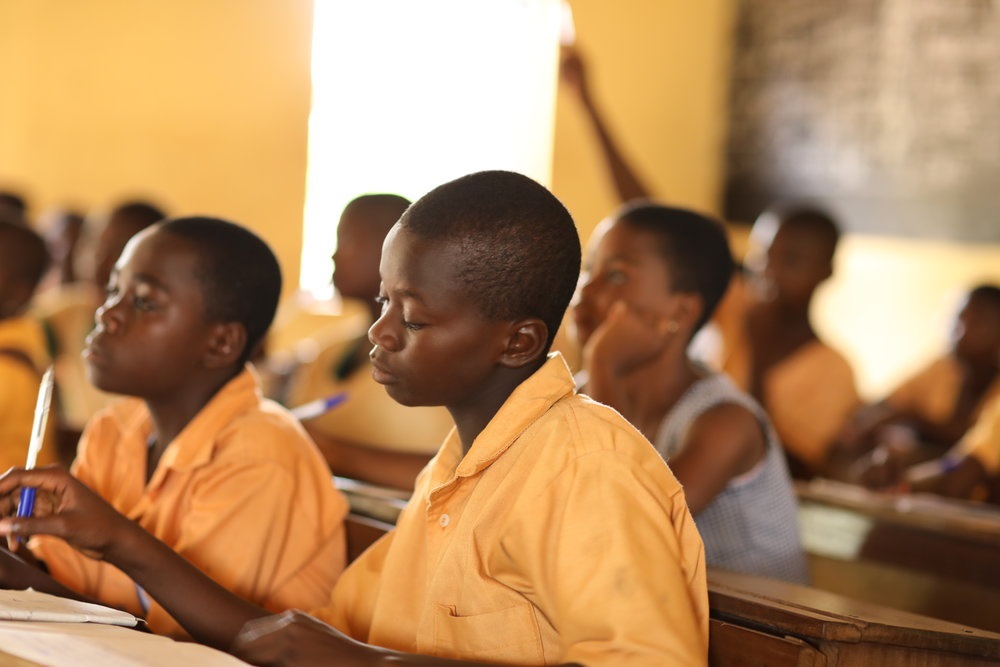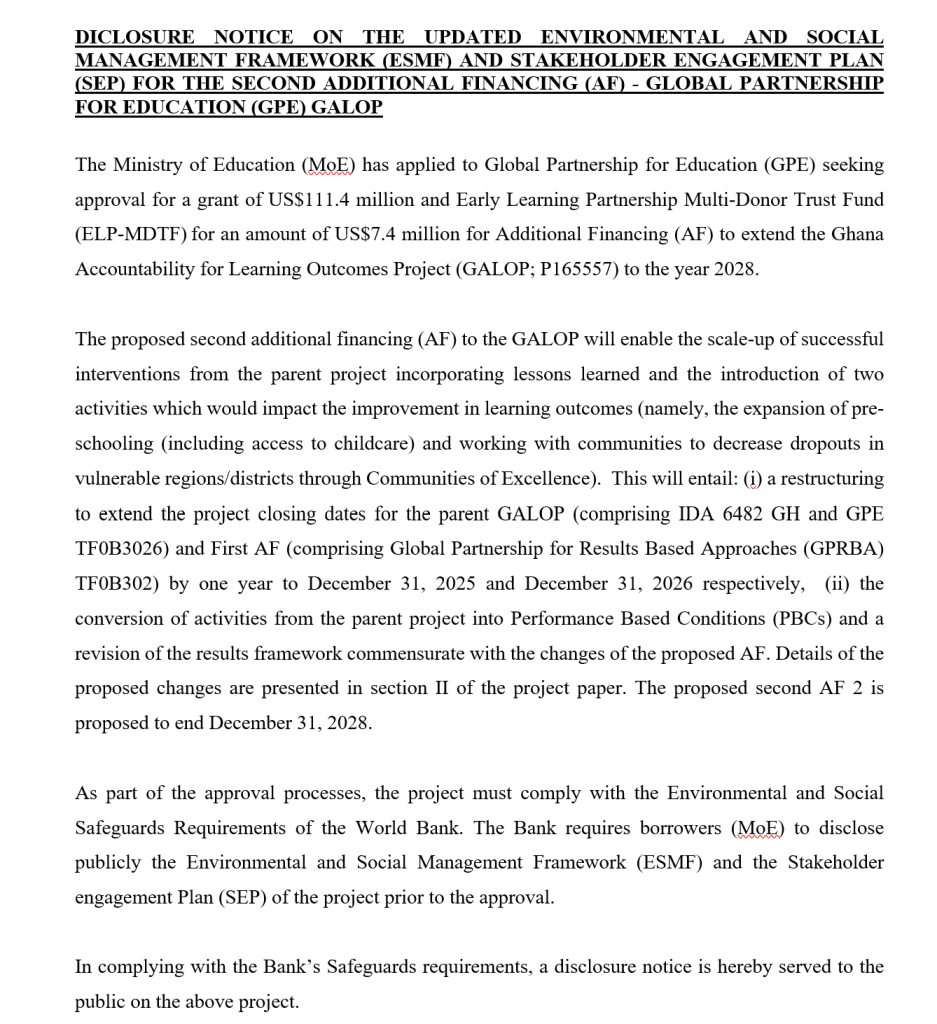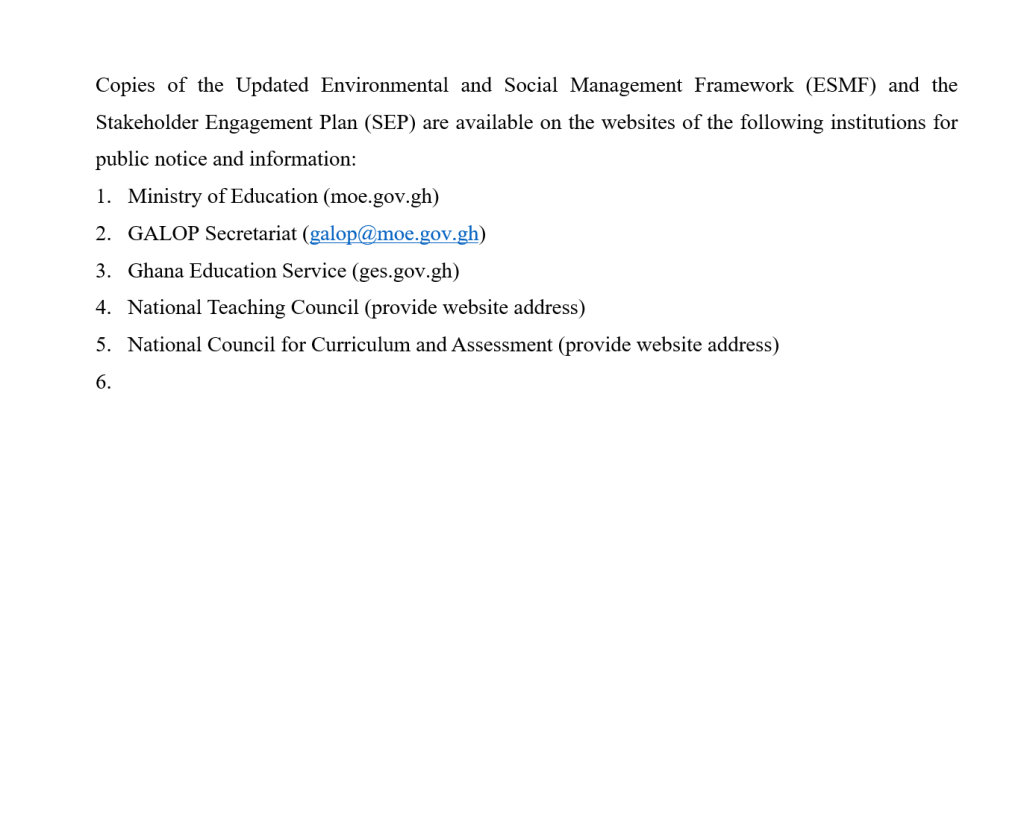The Ghana Accountability for Learning Outcomes Project (GALOP) is a five-year project with the objective to improve the quality of education in low-performing basic education schools and strengthen education sector equity and accountability in Ghana.
GALOP is focused on the 10,000 lowest performing Basic Schools (Kindergarten, Primary and Junior High Schools) and all 28 special schools. It also focuses on strengthening the accountability of the entire education system
GALOP supports the equitable quality education commitment through targeted interventions to the most disadvantaged schools and children across the country.
Component 1: Strengthen teaching and learning through support and resources for teachers
- Sub-component 1.1: Innovative Delivery of INSET – GES and NTC have developed an INSET framework linked with a CPD calendar. Teachers in GALOP schools will receive specific INSET (Targeted Instruction, Safe Schools, Digital Literacy, Training for Special School Teachers
- Sub-component 1.2: Coaching and Mentoring – GES and NTC have developed a coaching and mentoring framework. Headteachers and SISOs will receive training in supporting teachers in GALOP schools.
- Sub-component 1.3: TLMs – The appropriate TLMs for the INSET will be developed and delivered to GALOP schools.
Component 2: Strengthen school support, management and resourcing
- Sub-component 2.1: Learning Grants – All 10,028 GALOP schools will receive Learning Grants, in addition to the capitation grant.
- Sub-component 2.2: District Strengthening – Districts will receive a grant and capacity building based on needs and number of GALOP schools in the district.
- Sub-component 2.3: SMC – all GALOP schools will establish functioning SMCs
- Sub-component 2.4: Strengthened support to schools and OOSC through outcomes-based commissioning
- Some GALOP districts also have high number of OOSC. Service Providers and Social Investors will partner MOE/GES and deliver CBE programs for about 70,000 OOSC, in and around 700 GALOP schools catchment areas.
- The Service Providers and Social Investors will also provide additional support to the 700 GALOP schools, where the OOSC will be mainstreamed following the CBE program.
- These Social Investors will only be paid based on outcomes achieved. They will be contracted by MOE and be required to follow MOE/GES regulations.
Component 3: Strengthen accountability systems for learning – system level component (all schools)
- Sub-component 3.1: Improved accountability for learning in public basic schools. Development of Accountability Framework for Basic Education and an Accountability Dashboard for harmonised data collection with a harmonised collection tool.
- Sub-component 3.2: Assessment Systems – Development of a national assessment strategy (operational plan) and P4 assessment
- Sub-component 3.3: Equitable distribution of Teachers – Development of a Teacher Deployment and Transfer Strategy to improve distribution of trained teachers.
Component 4: Technical assistance, institutional strengthening, monitoring, and research
- Sub-component 4.1: Technical assistance for capacity building and institutional strengthening
- Sub-component 4.2: Monitoring and evaluation, management and operational costs
- Sub-component 5.1: Strengthening remote education service delivery – content reform and delivery (TV and Radio tutorials, online and offline help desk, Digital Library on a Learning Management System) and INSET (digital literacy and delivery of digital lessons).
- Sub-component 5.2: Support to safe schools reopening and reentry – WASH interventions, public awareness and communications campaign, remedial and accelerated learning programs for poor performing learners.
- Sub-component 5.3: Strengthening management for education sector resilience – Development of first phase of a LMS, Lessons for the proposed National Knowledge and Skills Bank and alignment of policies around technology usage in schools to facilitate teaching and learning.
- Delivering teacher capacity building and innovative in-service training
- Schools-based support and instructional leadership.
- Provision of teaching and learning materials.
- Enhancing provision of learning grants to support learning activities.
- Strengthening district education management capacity.
- Strengthening School Management Committees for enhanced citizen engagement.
- Supporting the safe re-opening of schools and safe re-entry.
- Strengthening support for schools and out-of-school children through outcomes-based commissioning.
- Developing and implementing an accountability for learning framework.
- Development and implementation of a national assessment strategy.
- Strengthening SMCs for enhanced citizen engagement.
- Policy reforms for efficient education sector human resource management, administrative and leadership practices.
- Technical assistance, institutional strengthening, monitoring and research.
- Strengthening remote education service delivery.
- Continuity of learning during school closures.
- Improved capacity of teachers to facilitate digital education.
- Safe re-opening of schools and safeguarding of students post-COVID-19.
- Strengthened education system management for resilience against future shocks.
- Improved teaching practices in schools.
- Strengthened school level accountability through sharing of key data.
- Improved literacy and numeracy outcomes and readiness for school.
- Sustained retention of out-of-school children.
- Improved quality of education in low performing basic education schools.
- Improved capacity of education system; strengthened education sector equity and accountability
- Improved learning outcomes are sustained beyond the project period.
- Improved effectiveness of future government and donor expenditure on learning outcomes.
- Improved capacity of the education sector to respond to shocks.
BENEFITS OF GALOP
1. Enhanced capacity of teachers through continuous professional development..
2. Enhanced capacity of heads of schools to effectively manage schools for improved outcomes.
3. Provision of Learning Grants as additional resources to the Capitation Grants.
4. Enhanced capacity of School Improvement Support Officers (SISOs) to strengthen school inspections and supervision
5. Enhanced capacity of District Education Directorates through education management training and provision of District Grants.
6. Development and distribution of Teaching and Learning Materials (TLMs) on the national curriculum.
7. Promote equitable deployment of trained teachers and incentivise teachers’ deployment to rural areas.
8. Strengthen School Management Committees (SMCs) to promote school-community engagement.
Supply of quality TLMs to special schools.”
Key Facts
- Approximately 2.4 million pupils to benefit from the program.
- 76,000 teachers engaged.
- All School Management Committee (SMC) members in the 10,028 targeted schools to benefit from management training programmes.
- Heads of targeted schools to receive training in leadership and accountability.
- Capacities to be built for 1,300 staff from all 260 District Directorates of Education.
- Capacities to be built for all School Improvement Support Officers, staff of Regional Education Directorates, Ghana Education Service Headquarters, and Regulatory Agencies of the Ministry of Education.

SELECTION CRITERIA
The 10,000 schools were selected using objective and transparent criteria and based on a composite index constructed using the following indicators:
(i) BECE raw scores
(ii) Percentage trained teachers
(iii) Average class size
(iv) Poverty index at the district level.
Based on the composite index, schools in the country were ranked and the bottom 10,000 schools were selected. Selected schools are spread across the country.
FAQs
1. What is GALOP?
The Ghana Accountability for Learning Outcomes Project (GALOP) is a five-year project with the objective to improve the quality of education in low-performing basic education schools and strengthen education sector equity and accountability in Ghana.
The project targets the 10,000 lowest-performing Basic Schools (Kindergarten, Primary and Junior High Schools) and all special schools with direct interventions.
2. Why GALOP?
“Data on basic education in Ghana show that access to quality education is inequitable. There are variations in the quality of Basic Schools and a considerable number of children are out of school. Consequently, the Education Strategic Plan (ESP 2018–2030) commits to providing equitable access to quality basic education to all children.
GALOP supports the commitment to equitable access to quality education through targeted interventions at the most disadvantaged schools, benefitting children across the country.”
3. How much does the project cost, and how is it being funded?
The total project amount is US$218.7 million. It is jointly funded by the World Bank, Department for International Development (DFID) and the Global Partnership for Education (GPE).
GALOP is a results-based financing project. Disbursement of project funds to the Ministry of Education is contingent on the achievement of pre-determined results.
4. What are the benefits of GALOP?
To achieve the project’s objective, the school system will benefit from the following:
• Enhanced capacity of teachers to effectively discharge their duties through continuous professional development.
• Enhanced capacity of heads of schools to effectively manage schools for improved outcomes.
• Enhanced capacity of Circuit Supervisors to strengthen school inspections and supervision.
• Enhanced capacity of District Education Directorates through training in education management and the provision of District Grants.
• Promotion of the equitable deployment of trained teachers and incentivisation of teachers’ deployment to rural areas.
• Strengthening of School Management Committees (SMCs) to promote school-community engagement.
• Provision of Learning Grants in addition to the Capitation Grants.
• Development and distribution of Teaching and Learning Materials (TLMs) on the national curriculum.
• Supply of quality TLMs to special schools.
6. Who are direct and indirect beneficiaries of GALOP?
In total, about 2,328,750 pupils and 76,000 teachers from the targeted basic schools would directly benefit from the various interventions under the project. In addition, all School Management Committee members in the targeted schools will benefit from management training while the heads of the targeted schools will also benefit from leadership and accountability training. About 1,300 staff from 260 districts will benefit directly from the capacity building training. All Circuit Supervisors, the staff of Regional Education Directorates, Ghana Education Service Headquarters, and Regulatory Agencies of the Ministry of Education will benefit from the project’s capacity building initiatives
7. How long is the project expected to last?
Five years. However, the ambition is to identify interventions under the project that are cost-effective in order to scale them up. Many of the systemic interventions and activities under the project will continue long after the five years.
8. How many schools are involved?
Project interventions are targeted at 10,000 low-performing Basic Schools and all Special Schools in Ghana. In addition, the project also supports strengthening the accountability of the entire education system.
9. How were these schools selected?
The 10,000 schools were selected using objective and transparent criteria on a composite index using the following indicators:
(i) BECE raw scores
(ii) Percentage of trained teachers
(iii) Average class size
(iv) Poverty index at the district level
Schools in the country were ranked based on their composite index score. The bottom 10,000 schools on the ranking were selected. The selected schools are spread across the country.
10. What happens at the end of the project period?
Project interventions and activities will be evaluated to identify those that contribute effectively to the achievement of the project objective. Effective measures will be sustained in beneficiary schools and scaled to all schools in the country.
11. How will progress be measured during the project?
The project has a comprehensive results framework with 31 indicators to monitor the progress. Progress will be monitored on an annual basis. The indicators are related to the activities under the project.
In addition, the project will include impact evaluations to measure the overall effects of the project.
12. What is the project scope?
The scope of the project is countrywide. Beneficiary schools are spread across all 260 districts in the country. Each District Education Office will be supported to oversee implementation.”
13. Will the government continue to pay Capitation Grants to the selected schools?
Yes. The learning grants will be disbursed to the targeted schools in addition to the Capitation Grants.
14. What happens to non GALOP schools?
Non-GALOP schools are not amongst the 10,000 selected low-performing schools in the country. All non-GALOP schools are within districts that will receive capacity building and strengthening under this project, which will improve the support from the districts to all schools in the country.
The project’s interventions to strengthen system accountability, develop a national assessment strategy and conduct the P4 national standardized assessment tests will benefit non-GALOP schools. In addition, all schools will benefit from the Teacher Deployment and Transfer Strategy that ensures the equitable distribution of trained teachers across schools in the country.
15. What happens to staff of these selected schools?
Staff in the targeted GALOP schools will remain on GES payroll and contracts. Teaching staff will receive additional training, mentoring and coaching support under the project.”
16. Will staff of these selected schools be given incentives to ensure their retention during the period of the project?
Teachers in the targeted schools will receive additional INSET and coaching and mentoring from head teachers and SISOs. These incentives will provide additional support to staff in the targeted schools.
17. What consultations have taken place or have been planned ahead of the project implementation?
Consultations were held with Regional and District Education Directorates, Circuit Supervisors, teachers, head teachers, coalitions of NGOs in education, development partners, academics and other stakeholders in the design of the project. Additional stakeholder engagements will be held before project implementation


